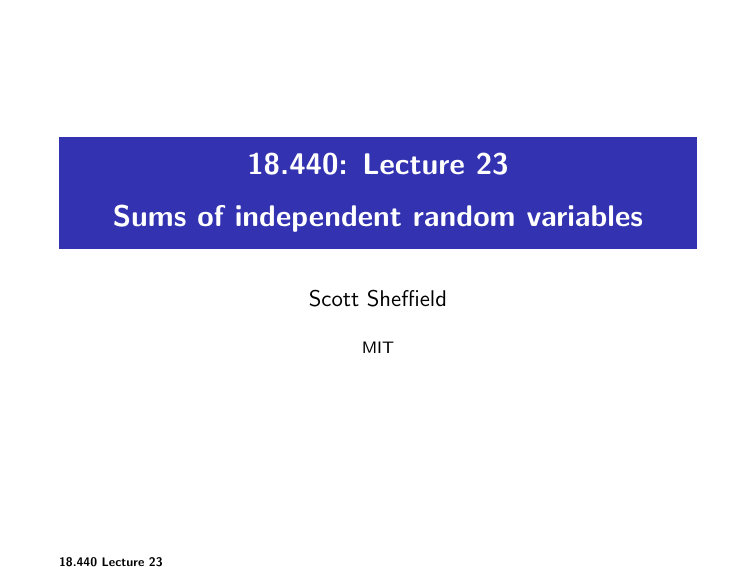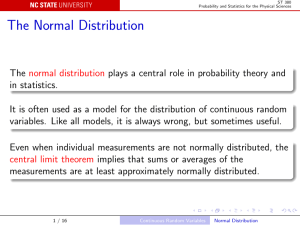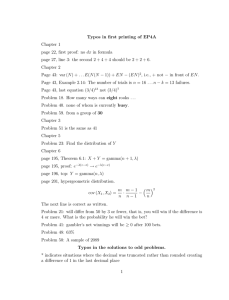18.440: Lecture 23 Sums of independent random variables Scott Sheffield MIT
advertisement

18.440: Lecture 23
Sums of independent random variables
Scott Sheffield
MIT
18.440 Lecture 23
Summing two random variables
I
Say we have independent random variables X and Y and we
know their density functions fX and fY .
18.440 Lecture 23
Summing two random variables
I
Say we have independent random variables X and Y and we
know their density functions fX and fY .
I
Now let’s try to find FX +Y (a) = P{X + Y ≤ a}.
18.440 Lecture 23
Summing two random variables
I
Say we have independent random variables X and Y and we
know their density functions fX and fY .
I
Now let’s try to find FX +Y (a) = P{X + Y ≤ a}.
I
This is the integral over {(x, y ) : x + y ≤ a} of
f (x, y ) = fX (x)fY (y ). Thus,
18.440 Lecture 23
Summing two random variables
I
Say we have independent random variables X and Y and we
know their density functions fX and fY .
I
Now let’s try to find FX +Y (a) = P{X + Y ≤ a}.
I
This is the integral over {(x, y ) : x + y ≤ a} of
f (x, y ) = fX (x)fY (y ). Thus,
I
Z
∞
Z
a−y
P{X + Y ≤ a} =
fX (x)fY (y )dxdy
−∞
Z
∞
FX (a − y )fY (y )dy .
=
−∞
18.440 Lecture 23
−∞
Summing two random variables
I
Say we have independent random variables X and Y and we
know their density functions fX and fY .
I
Now let’s try to find FX +Y (a) = P{X + Y ≤ a}.
I
This is the integral over {(x, y ) : x + y ≤ a} of
f (x, y ) = fX (x)fY (y ). Thus,
I
Z
∞
Z
a−y
P{X + Y ≤ a} =
fX (x)fY (y )dxdy
−∞
Z
−∞
∞
FX (a − y )fY (y )dy .
=
−∞
I
DifferentiatingRboth sides gives
R∞
∞
d
fX +Y (a) = da
F
(a−y
)f
(y
)dy
=
X
Y
−∞
−∞ fX (a−y )fY (y )dy .
18.440 Lecture 23
Summing two random variables
I
Say we have independent random variables X and Y and we
know their density functions fX and fY .
I
Now let’s try to find FX +Y (a) = P{X + Y ≤ a}.
I
This is the integral over {(x, y ) : x + y ≤ a} of
f (x, y ) = fX (x)fY (y ). Thus,
I
Z
∞
Z
a−y
P{X + Y ≤ a} =
fX (x)fY (y )dxdy
−∞
Z
−∞
∞
FX (a − y )fY (y )dy .
=
−∞
I
DifferentiatingRboth sides gives
R∞
∞
d
fX +Y (a) = da
F
(a−y
)f
(y
)dy
=
X
Y
−∞
−∞ fX (a−y )fY (y )dy .
I
Latter formula makes some intuitive sense. We’re integrating
over the set of x, y pairs that add up to a.
18.440 Lecture 23
Independent identically distributed (i.i.d.)
I
The abbreviation i.i.d. means independent identically
distributed.
Independent identically distributed (i.i.d.)
I
The abbreviation i.i.d. means independent identically
distributed.
I
It is actually one of the most important abbreviations in
probability theory.
Independent identically distributed (i.i.d.)
I
The abbreviation i.i.d. means independent identically
distributed.
I
It is actually one of the most important abbreviations in
probability theory.
I
Worth memorizing.
Summing i.i.d. uniform random variables
I
Suppose that X and Y are i.i.d. and uniform on [0, 1]. So
fX = fY = 1 on [0, 1].
18.440 Lecture 23
Summing i.i.d. uniform random variables
I
Suppose that X and Y are i.i.d. and uniform on [0, 1]. So
fX = fY = 1 on [0, 1].
I
What is the probability density function of X + Y ?
18.440 Lecture 23
Summing i.i.d. uniform random variables
I
Suppose that X and Y are i.i.d. and uniform on [0, 1]. So
fX = fY = 1 on [0, 1].
I
What is the probability density function of X + Y ?
R∞
R1
fX +Y (a) = −∞ fX (a − y )fY (y )dy = 0 fX (a − y ) which is
the length of [0, 1] ∩ [a − 1, a].
I
18.440 Lecture 23
Summing i.i.d. uniform random variables
I
Suppose that X and Y are i.i.d. and uniform on [0, 1]. So
fX = fY = 1 on [0, 1].
I
What is the probability density function of X + Y ?
R∞
R1
fX +Y (a) = −∞ fX (a − y )fY (y )dy = 0 fX (a − y ) which is
the length of [0, 1] ∩ [a − 1, a].
I
I
That’s a when a ∈ [0, 1] and 2 − a when a ∈ [1, 2] and 0
otherwise.
Review: summing i.i.d. geometric random variables
I
A geometric random variable X with parameter p has
P{X = k} = (1 − p)k−1 p for k ≥ 1.
18.440 Lecture 23
Review: summing i.i.d. geometric random variables
I
A geometric random variable X with parameter p has
P{X = k} = (1 − p)k−1 p for k ≥ 1.
I
Sum Z of n independent copies of X ?
18.440 Lecture 23
Review: summing i.i.d. geometric random variables
I
A geometric random variable X with parameter p has
P{X = k} = (1 − p)k−1 p for k ≥ 1.
I
Sum Z of n independent copies of X ?
I
We can interpret Z as time slot where nth head occurs in
i.i.d. sequence of p-coin tosses.
18.440 Lecture 23
Review: summing i.i.d. geometric random variables
I
A geometric random variable X with parameter p has
P{X = k} = (1 − p)k−1 p for k ≥ 1.
I
Sum Z of n independent copies of X ?
I
We can interpret Z as time slot where nth head occurs in
i.i.d. sequence of p-coin tosses.
I
So Z is negative binomial
(n, p). So
k−1 n−1
P{Z = k} = n−1 p (1 − p)k−n p.
18.440 Lecture 23
Summing i.i.d. exponential random variables
I
Suppose X1 , . . . Xn are i.i.d. exponential random variables with
parameter λ. So fXi (x) = λe −λx on [0, ∞) for all 1 ≤ i ≤ n.
18.440 Lecture 23
Summing i.i.d. exponential random variables
I
I
Suppose X1 , . . . Xn are i.i.d. exponential random variables with
parameter λ. So fXi (x) = λe −λx on [0, ∞) for all 1 ≤ i ≤ n.
P
What is the law of Z = ni=1 Xi ?
18.440 Lecture 23
Summing i.i.d. exponential random variables
I
I
I
Suppose X1 , . . . Xn are i.i.d. exponential random variables with
parameter λ. So fXi (x) = λe −λx on [0, ∞) for all 1 ≤ i ≤ n.
P
What is the law of Z = ni=1 Xi ?
We claimed in an earlier lecture that this was a gamma
distribution with parameters (λ, n).
18.440 Lecture 23
Summing i.i.d. exponential random variables
I
I
Suppose X1 , . . . Xn are i.i.d. exponential random variables with
parameter λ. So fXi (x) = λe −λx on [0, ∞) for all 1 ≤ i ≤ n.
P
What is the law of Z = ni=1 Xi ?
I
We claimed in an earlier lecture that this was a gamma
distribution with parameters (λ, n).
I
So fZ (y ) =
18.440 Lecture 23
λe −λy (λy )n−1
.
Γ(n)
Summing i.i.d. exponential random variables
I
I
Suppose X1 , . . . Xn are i.i.d. exponential random variables with
parameter λ. So fXi (x) = λe −λx on [0, ∞) for all 1 ≤ i ≤ n.
P
What is the law of Z = ni=1 Xi ?
I
We claimed in an earlier lecture that this was a gamma
distribution with parameters (λ, n).
I
So fZ (y ) =
I
We argued this point by taking limits of negative binomial
distributions. Can we check it directly?
18.440 Lecture 23
λe −λy (λy )n−1
.
Γ(n)
Summing i.i.d. exponential random variables
I
I
Suppose X1 , . . . Xn are i.i.d. exponential random variables with
parameter λ. So fXi (x) = λe −λx on [0, ∞) for all 1 ≤ i ≤ n.
P
What is the law of Z = ni=1 Xi ?
I
We claimed in an earlier lecture that this was a gamma
distribution with parameters (λ, n).
I
So fZ (y ) =
I
We argued this point by taking limits of negative binomial
distributions. Can we check it directly?
I
By induction, would suffice to show that a gamma (λ, 1) plus
an independent gamma (λ, n) is a gamma (λ, n + 1).
18.440 Lecture 23
λe −λy (λy )n−1
.
Γ(n)
Summing independent gamma random variables
I
Say X is gamma (λ, s), Y is gamma (λ, t), and X and Y are
independent.
Summing independent gamma random variables
I
I
Say X is gamma (λ, s), Y is gamma (λ, t), and X and Y are
independent.
Intuitively, X is amount of time till we see s events, and Y is
amount of subsequent time till we see t more events.
Summing independent gamma random variables
I
I
I
Say X is gamma (λ, s), Y is gamma (λ, t), and X and Y are
independent.
Intuitively, X is amount of time till we see s events, and Y is
amount of subsequent time till we see t more events.
So fX (x) =
λe −λx (λx)s−1
Γ(s)
and fY (y ) =
λe −λy (λy )t−1
.
Γ(t)
Summing independent gamma random variables
I
I
Say X is gamma (λ, s), Y is gamma (λ, t), and X and Y are
independent.
Intuitively, X is amount of time till we see s events, and Y is
amount of subsequent time till we see t more events.
−λy (λy )t−1
λe −λx (λx)s−1
and fY (y ) = λe Γ(t)
.
Γ(s)
R∞
fX +Y (a) = −∞ fX (a − y )fY (y )dy .
I
So fX (x) =
I
Now
Summing independent gamma random variables
I
I
Say X is gamma (λ, s), Y is gamma (λ, t), and X and Y are
independent.
Intuitively, X is amount of time till we see s events, and Y is
amount of subsequent time till we see t more events.
−λy (λy )t−1
λe −λx (λx)s−1
and fY (y ) = λe Γ(t)
.
Γ(s)
R∞
fX +Y (a) = −∞ fX (a − y )fY (y )dy .
I
So fX (x) =
I
Now
Up to an a-independent multiplicative constant, this is
Z a
Z a
−λ(a−y )
s−1 −λy t−1
−λa
e
(a−y ) e
y dy = e
(a−y )s−1 y t−1 dy .
I
0
18.440 Lecture 23
0
Summing independent gamma random variables
I
I
Say X is gamma (λ, s), Y is gamma (λ, t), and X and Y are
independent.
Intuitively, X is amount of time till we see s events, and Y is
amount of subsequent time till we see t more events.
−λy (λy )t−1
λe −λx (λx)s−1
and fY (y ) = λe Γ(t)
.
Γ(s)
R∞
fX +Y (a) = −∞ fX (a − y )fY (y )dy .
I
So fX (x) =
I
Now
Up to an a-independent multiplicative constant, this is
Z a
Z a
−λ(a−y )
s−1 −λy t−1
−λa
e
(a−y ) e
y dy = e
(a−y )s−1 y t−1 dy .
I
0
I
Letting x = y /a, this becomes
R1
e −λa as+t−1 0 (1 − x)s−1 x t−1 dx.
18.440 Lecture 23
0
Summing independent gamma random variables
I
I
Say X is gamma (λ, s), Y is gamma (λ, t), and X and Y are
independent.
Intuitively, X is amount of time till we see s events, and Y is
amount of subsequent time till we see t more events.
−λy (λy )t−1
λe −λx (λx)s−1
and fY (y ) = λe Γ(t)
.
Γ(s)
R∞
fX +Y (a) = −∞ fX (a − y )fY (y )dy .
I
So fX (x) =
I
Now
Up to an a-independent multiplicative constant, this is
Z a
Z a
−λ(a−y )
s−1 −λy t−1
−λa
e
(a−y ) e
y dy = e
(a−y )s−1 y t−1 dy .
I
0
I
I
0
Letting x = y /a, this becomes
R1
e −λa as+t−1 0 (1 − x)s−1 x t−1 dx.
This is (up to multiplicative constant) e −λa as+t−1 . Constant
must be such that integral from −∞ to ∞ is 1. Conclude
that X + Y is gamma (λ, s + t).
18.440 Lecture 23
Summing two normal variables
I
X is normal with mean zero, variance σ12 , Y is normal with
mean zero, variance σ22 .
Summing two normal variables
I
X is normal with mean zero, variance σ12 , Y is normal with
mean zero, variance σ22 .
I
fX (x) =
√ 1 e
2πσ1
−x 2
2σ 2
1
and fY (y ) =
√ 1 e
2πσ2
−y 2
2σ 2
2
.
Summing two normal variables
I
X is normal with mean zero, variance σ12 , Y is normal with
mean zero, variance σ22 .
I
fX (x) =
I
We just need to compute
√ 1 e
2πσ1
−x 2
2σ 2
1
−y 2
2
√ 1 e 2σ2 .
2πσ2
R∞
fX +Y (a) = −∞ fX (a
and fY (y ) =
− y )fY (y )dy .
Summing two normal variables
I
X is normal with mean zero, variance σ12 , Y is normal with
mean zero, variance σ22 .
I
fX (x) =
I
We just need to compute
We could compute this directly.
I
√ 1 e
2πσ1
−x 2
2σ 2
1
−y 2
2
√ 1 e 2σ2 .
2πσ2
R∞
fX +Y (a) = −∞ fX (a
and fY (y ) =
− y )fY (y )dy .
Summing two normal variables
I
X is normal with mean zero, variance σ12 , Y is normal with
mean zero, variance σ22 .
I
fX (x) =
I
We just need to compute
− y )fY (y )dy .
We could compute this directly.
Or we could argue with a multi-dimensional bell curve picture
that if X and Y have variance 1 then fσ1 X +σ2 Y is the density
of a normal random variable (and note that variances and
expectations are additive).
I
I
18.440 Lecture 23
√ 1 e
2πσ1
−x 2
2σ 2
1
−y 2
2
√ 1 e 2σ2 .
2πσ2
R∞
fX +Y (a) = −∞ fX (a
and fY (y ) =
Summing two normal variables
I
X is normal with mean zero, variance σ12 , Y is normal with
mean zero, variance σ22 .
I
fX (x) =
I
We just need to compute
− y )fY (y )dy .
We could compute this directly.
Or we could argue with a multi-dimensional bell curve picture
that if X and Y have variance 1 then fσ1 X +σ2 Y is the density
of a normal random variable (and note that variances and
expectations are additive).
Or use fact that if Ai ∈ {−1, 1} are i.i.d. coin tosses then
Pσ2 N
2
√1
i=1 Ai is approximately normal with variance σ when
N
N is large.
I
I
I
18.440 Lecture 23
√ 1 e
2πσ1
−x 2
2σ 2
1
−y 2
2
√ 1 e 2σ2 .
2πσ2
R∞
fX +Y (a) = −∞ fX (a
and fY (y ) =
Summing two normal variables
I
X is normal with mean zero, variance σ12 , Y is normal with
mean zero, variance σ22 .
I
fX (x) =
I
We just need to compute
− y )fY (y )dy .
We could compute this directly.
Or we could argue with a multi-dimensional bell curve picture
that if X and Y have variance 1 then fσ1 X +σ2 Y is the density
of a normal random variable (and note that variances and
expectations are additive).
Or use fact that if Ai ∈ {−1, 1} are i.i.d. coin tosses then
Pσ2 N
2
√1
i=1 Ai is approximately normal with variance σ when
N
N is large.
Generally: if independent
random P
variables P
Xj are normal
P
(µj , σj2 ) then nj=1 Xj is normal ( nj=1 µj , nj=1 σj2 ).
I
I
I
I
18.440 Lecture 23
√ 1 e
2πσ1
−x 2
2σ 2
1
−y 2
2
√ 1 e 2σ2 .
2πσ2
R∞
fX +Y (a) = −∞ fX (a
and fY (y ) =
Other sums
I
Sum of an independent binomial (m, p) and binomial (n, p)?
Other sums
I
Sum of an independent binomial (m, p) and binomial (n, p)?
I
Yes, binomial (m + n, p). Can be seen from coin toss
interpretation.
Other sums
I
Sum of an independent binomial (m, p) and binomial (n, p)?
I
Yes, binomial (m + n, p). Can be seen from coin toss
interpretation.
I
Sum of independent Poisson λ1 and Poisson λ2 ?
Other sums
I
Sum of an independent binomial (m, p) and binomial (n, p)?
I
Yes, binomial (m + n, p). Can be seen from coin toss
interpretation.
I
Sum of independent Poisson λ1 and Poisson λ2 ?
I
Yes, Poisson λ1 + λ2 . Can be seen from Poisson point process
interpretation.





